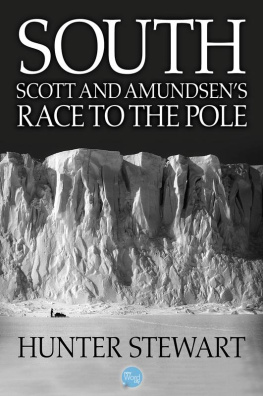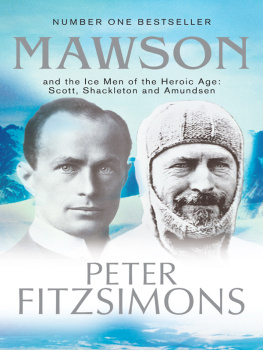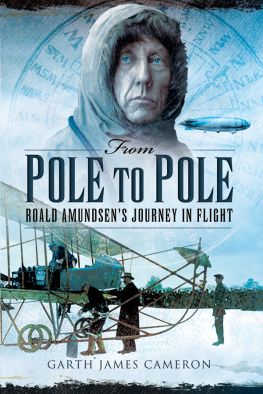THE SOUTH POLE

ROALD AMUNDSEN.
THE SOUTH POLE
AN ACCOUNT OF THE NORWEGIAN
ANTARCTIC EXPEDITION IN THE FRAM,
19101912
BY CAPTAIN ROALD AMUNDSEN
FOREWORD BY
FRIDTJOF NANSEN
NEW INTRODUCTION BY
ROLAND HUNTFORD
TRANSLATED FROM THE NORWEGIAN BY
A. G. CHATER
WITH MAPS AND NUMEROUS ILLUSTRATIONS

First Cooper Square Press edition 2001
This Cooper Square Press paperback edition of The South Pole is an unabridged republication of the edition first published in two volumes in New York in 1913, and here combined into one volume and supplemented with a new introduction by Roland Huntford.
New introduction copyright 2001 by Roland Huntford
All rights reserved.
Published by Cooper Square Press
An Imprint of the Rowman & Littlefield Publishing Group
150 Fifth Avenue, Suite 911
New York, New York 10011
Distributed by National Book Network
Library of Congress Cataloging-in-Publication Data
Amundsen, Roald, 18721928.
[Sydpolen. English]
The South Pole : an account of the Norwegian Antarctic Expedition in the Fram, 19101912 / by Roald Amundsen ; foreword by Fridtjof Nansen; new introduction by Roland Huntford; translated from the Norwegian by A. G. Chater. 1st Cooper Square Press ed.
p. cm.
Originally published in 2 volumes: London : J. Murray, 1913.
Includes bibliographical references (p. ).
ISBN 978-0-8154-1127-7
1. South PoleDiscovery and exploration. 2. AntarcticaDiscovery and exploration. 3. Amundsen, Roald, 18721928JourneysAntarctica. I. Title.
G850 1910 .A5213 2001b
919.89dc21 00-048562
 The paper used in this publication meets the minimum requirements of American National Standard for Information SciencesPermanence of Paper for Printed Library Materials, ANSI/NISO Z39.481992.
The paper used in this publication meets the minimum requirements of American National Standard for Information SciencesPermanence of Paper for Printed Library Materials, ANSI/NISO Z39.481992.
Manufactured in the United States of America.
TO
MY COMRADES,
THE BRAVE LITTLE BAND THAT PROMISED
IN FUNCHAL ROADS
TO STAND BY ME IN THE STRUGGLE FOR THE
SOUTH POLE,
I DEDICATE THIS BOOK.
ROALD AMUNDSEN.
URANIENBORG,
August 15, 1912.
CONTENTS
BY ROLAND HUNTFORD
BY FRIDTJOF NANSEN
BY ROALD AMUNDSEN
First-Lieutenant Thorvald Nilsen |
Commodore Christian Blom |
B. J. Birkeland |
J. Schetelig |
A. Alexander, with note by Professor H. Geelmuyden |
Professors Bjrn Hellen-Hansen and Fridtjf Nansen |
LIST OF ILLUSTRATIONS TO VOL. I
Reproduced by permission of the DAILY CHRONICLE
Reproduced by permission of the ILLUSTRATED LONDON NEWS
Reproduced by permission of the ILLUSTRATED LONDON NEWS
Reproduced by permission of the ILLUSTRATED LONDON NEWS
Reproduced by permission of the ILLUSTRATED LONDON NEWS
Reproduced by permission of the ILLUSTRATED LONDON NEWS
Reproduced by permission of the ILLUSTRATED LONDON NEWS.
SOME OF THE LAND PARTY IN WINTER COSTUME

LIST OF ILLUSTRATIONS TO VOL. II
Reproduced by permission of the ILLUSTRATED LONDON NEWS
Reproduced by permission of the ILLUSTRATED LONDON NEWS
Reproduced by permission of the ILLUSTRATED LONDON NEWS
Reproduced by permission of the ILLUSTRATED LONDON NEWS
Reproduced by permission of the ILLUSTRATED LONDON NEWS
Reproduced by permission of the ILLUSTRATED LONDON NEWS
Reproduced by permission of the ILLUSTRATED LONDON NEWS
Reproduced by permission of the ILLUSTRATED LONDON NEWS

SECTIONAL DIAGRAMS OF THE FRAM
LIST OF MAPS AND CHARTS
INTRODUCTION
THE race for the South Pole was one of the great symbolic events that opened the twentieth century and ushered in the modern age. For too long this story, told by Amundsen, the victor, was overshadowed by the apologia of Scott, the loser. Style is the man. Amundsens account is all that Scotts is not. It honors those who blazed the trail. It is wry, free of posturing, informative, honest of purpose, and understated, with a subtext of drama that even the barrier of translation cannot conceal.
The South Pole (first published in two volumes in 1913), however, is more than a mere chronicle of winning. It is the exhilarating tale of someone doing exactly what he had intended. That is the true definition of success, and it is a rarity. This book is also the record of the greatest snow journey ever made, the culmination of the classic age of polar exploration before the advent of flying and mechanical transport. It was the historic deed that ended terrestrial discovery, paving the way for mans leap into space.
Like most great feats, Amundsens journey was deceptively simple. On October 20, 1911, together with four companions and fifty-two dogs, he left his base at the Bay of Whales on the Antarctic Ross Sea coast. Ninety-nine days later, he and all his men came back healthy and untroubled. In the meanwhile, Amundsen had covered 1,400 miles; climbed 10,000 feet; pioneered a completely new route to the Antarctic ice cap; and planted the Norwegian flag at the South Pole. Done with a minimum of discomfort and an economy of means, it was a model of the elegant solution.
It was an extraordinary achievement, and it needed an extraordinary man. Amundsen had already been south before. At the end of the nineteenth century he had served on The Belgica, a ship that, under the Belgian flag, carried the first men known to have wintered in the Antarctic. Amundsen followed that achievement by leading his first expedition. In 19031906, he became the first to navigate the Northwest Passage from end to end, finishing a quest of centuries through the North American Arctic for a sea route between the Atlantic and the Pacific. Along the way Amundsen was also the first to prove in the field that the North Magnetic Pole was moving. Here, too, he joined the select band of those who did what they had set out to do. His successful navigation of the Northwest Passage was a dress rehearsal for the conquest of the South Poleeven to the extent of a Norwegian snatching the prize in what had been considered a British preserve. National sentiment, then as now, was a driving force.
Unlike other polar explorers, Amundsen was no adventurer. He was the embodiment of the artist as man of action. This explains much of his behavior. No artist wants to exhibit half-finished work. Amundsen scorned the grand departure. Both at the start of his voyage through the Northwest Passage and en route to the South Pole, he preferred to slip away at midnightliterallyunobserved. Even allowing for chronic penury and a shyness before creditors, under any circumstances Amundsen preferred to let publicity wait upon success. In any case, he had the true artists desire for praise of his work and not himself.
Next page










 The paper used in this publication meets the minimum requirements of American National Standard for Information SciencesPermanence of Paper for Printed Library Materials, ANSI/NISO Z39.481992.
The paper used in this publication meets the minimum requirements of American National Standard for Information SciencesPermanence of Paper for Printed Library Materials, ANSI/NISO Z39.481992.